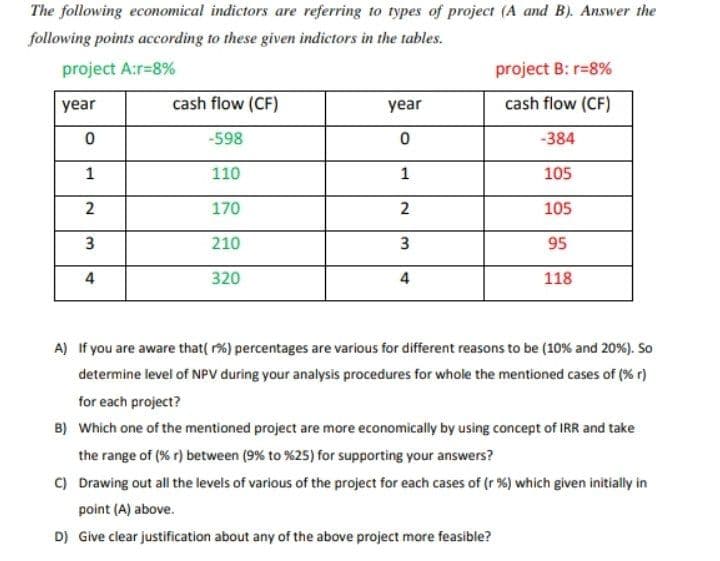The following economical indictors are referring to types of project (A and B). Answer the following points according to these given indictors in the tables. project A:r=8% project B: r=8% year cash flow (CF) year cash flow (CF) 0 -598 0 -384 1 110 1 105 2 170 2 105 3 210 3 95 4 320 118 A) If you are aware that (r%) percentages are various for different reasons to be (10% and 20%). So determine level of NPV during your analysis procedures for whole the mentioned cases of (% r) for each project? B) Which one of the mentioned project are more economically by using concept of IRR and take the range of (% r) between (9% to %25 ) for supporting your answers? 4
The following economical indictors are referring to types of project (A and B). Answer the following points according to these given indictors in the tables. project A:r=8% project B: r=8% year cash flow (CF) year cash flow (CF) 0 -598 0 -384 1 110 1 105 2 170 2 105 3 210 3 95 4 320 118 A) If you are aware that (r%) percentages are various for different reasons to be (10% and 20%). So determine level of NPV during your analysis procedures for whole the mentioned cases of (% r) for each project? B) Which one of the mentioned project are more economically by using concept of IRR and take the range of (% r) between (9% to %25 ) for supporting your answers? 4
Intermediate Financial Management (MindTap Course List)
13th Edition
ISBN:9781337395083
Author:Eugene F. Brigham, Phillip R. Daves
Publisher:Eugene F. Brigham, Phillip R. Daves
Chapter12: Capital Budgeting: Decision Criteria
Section: Chapter Questions
Problem 13P
Related questions
Question

Transcribed Image Text:The following economical indictors are referring to types of project (A and B). Answer the
following points according to these given indictors in the tables.
project A:r=8%
project B: r=8%
year
cash flow (CF)
year
cash flow (CF)
-598
-384
1
110
1
105
170
105
3
210
3
95
320
4
118
A) If you are aware that( r%) percentages are various for different reasons to be (10% and 20%). So
determine level of NPV during your analysis procedures for whole the mentioned cases of (% r)
for each project?
B) Which one of the mentioned project are more economically by using concept of IRR and take
the range of (% r) between (9% to %25) for supporting your answers?
C) Drawing out all the levels of various of the project for each cases of (r %) which given initially in
point (A) above.
D) Give clear justification about any of the above project more feasible?
Expert Solution
This question has been solved!
Explore an expertly crafted, step-by-step solution for a thorough understanding of key concepts.
Step by step
Solved in 3 steps with 4 images

Knowledge Booster
Learn more about
Need a deep-dive on the concept behind this application? Look no further. Learn more about this topic, finance and related others by exploring similar questions and additional content below.Recommended textbooks for you

Intermediate Financial Management (MindTap Course…
Finance
ISBN:
9781337395083
Author:
Eugene F. Brigham, Phillip R. Daves
Publisher:
Cengage Learning

EBK CONTEMPORARY FINANCIAL MANAGEMENT
Finance
ISBN:
9781337514835
Author:
MOYER
Publisher:
CENGAGE LEARNING - CONSIGNMENT

Survey of Accounting (Accounting I)
Accounting
ISBN:
9781305961883
Author:
Carl Warren
Publisher:
Cengage Learning

Intermediate Financial Management (MindTap Course…
Finance
ISBN:
9781337395083
Author:
Eugene F. Brigham, Phillip R. Daves
Publisher:
Cengage Learning

EBK CONTEMPORARY FINANCIAL MANAGEMENT
Finance
ISBN:
9781337514835
Author:
MOYER
Publisher:
CENGAGE LEARNING - CONSIGNMENT

Survey of Accounting (Accounting I)
Accounting
ISBN:
9781305961883
Author:
Carl Warren
Publisher:
Cengage Learning

Essentials of Business Analytics (MindTap Course …
Statistics
ISBN:
9781305627734
Author:
Jeffrey D. Camm, James J. Cochran, Michael J. Fry, Jeffrey W. Ohlmann, David R. Anderson
Publisher:
Cengage Learning

Principles of Accounting Volume 2
Accounting
ISBN:
9781947172609
Author:
OpenStax
Publisher:
OpenStax College
